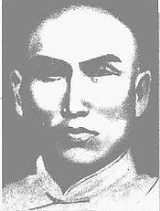
Yang Pan-hou
Encyclopedia
Yang Banhou (1837-1890) was an influential teacher of t'ai chi ch'uan (taijiquan) in Ch'ing dynasty
China
, known for his bellicose temperament.
to survive to adulthood. Like his father, he was retained as a martial arts instructor by the Chinese Imperial family
. He eventually became the formal teacher
of Wu Ch'uan-yu (Wu Quanyou)
, a Manchu
Banner cavalry
officer of the Palace Battalion. Wu Ch'uan-yu's son, Wu Chien-ch'uan (Wu Jianquan)
, also a Banner officer, became known as the co-founder (along with his father) of the Wu-style t'ai chi ch'uan
. Yang Pan-hou's younger brother Yang Chien-hou
was a well known teacher of Yang-style t'ai chi ch'uan as well. Yang Pan-hou's son, Yang Shao-p'eng (1875-1938) was also a t'ai chi teacher.
Yang Banhou taught Wang Jiao-Yu his father's Guang Ping Yang t'ai chi ch'uan
form, Wang Jiao-Yu taught Kuo Lien Ying
this original Yang style form.
Note: These are legendary or semi-legendary figures in the lineage, which means their involvement in the lineage, while accepted by most of the major schools, isn't independently verifiable from known historical records.
Qing Dynasty
The Qing Dynasty was the last dynasty of China, ruling from 1644 to 1912 with a brief, abortive restoration in 1917. It was preceded by the Ming Dynasty and followed by the Republic of China....
China
China
Chinese civilization may refer to:* China for more general discussion of the country.* Chinese culture* Greater China, the transnational community of ethnic Chinese.* History of China* Sinosphere, the area historically affected by Chinese culture...
, known for his bellicose temperament.
Biography
He was the senior son of Yang Lu-ch'anYang Lu-ch'an
Yang Lu-ch'an or Yang Luchan, ; also known as Yang Fu-k'ui , born in Kuang-p'ing , was an influential teacher of the soft style martial art t'ai chi ch'uan in China during the second half of the 19th century...
to survive to adulthood. Like his father, he was retained as a martial arts instructor by the Chinese Imperial family
Aisin Gioro
Aisin Gioro was the family name of the Manchu emperors of the Qing Dynasty. The House of Aisin Gioro ruled China until the Xinhai Revolution of 1911, which established a republican government in its place. The word aisin means gold in the Manchu language, and "gioro" is the name of the place in...
. He eventually became the formal teacher
Sifu
Shifu is the identical pronunciation of two Chinese terms for a master. The character 師 means “teacher”. The meaning of 傅 is “tutor”, and of 父, “father”. Both characters are read fu with the same tones in Cantonese and Mandarin, creating some ambiguity...
of Wu Ch'uan-yu (Wu Quanyou)
Wu Ch'uan-yu
Wu Ch'uan-yu or Wu Quanyou was an influential teacher of t'ai chi ch'uan in late Imperial China. He is credited as the founder of the Wu style t'ai chi ch'uan...
, a Manchu
Manchu
The Manchu people or Man are an ethnic minority of China who originated in Manchuria . During their rise in the 17th century, with the help of the Ming dynasty rebels , they came to power in China and founded the Qing Dynasty, which ruled China until the Xinhai Revolution of 1911, which...
Banner cavalry
Cavalry
Cavalry or horsemen were soldiers or warriors who fought mounted on horseback. Cavalry were historically the third oldest and the most mobile of the combat arms...
officer of the Palace Battalion. Wu Ch'uan-yu's son, Wu Chien-ch'uan (Wu Jianquan)
Wu Chien-ch'uan
Wu Chien-ch'uan , was a famous teacher of the neijia martial art of t'ai chi ch'uan in late Imperial and early Republican China....
, also a Banner officer, became known as the co-founder (along with his father) of the Wu-style t'ai chi ch'uan
Wu style tai chi chuan
The Wu family-style t'ai chi ch'uan of Wu Ch'uan-yu and Wu Chien-ch'uan is the second most popular form of t'ai chi ch'uan in the world today, after the Yang style, and fourth in terms of family seniority. This style is different from the Wu style of t'ai chi ch'uan founded by Wu Yu-hsiang...
. Yang Pan-hou's younger brother Yang Chien-hou
Yang Chien-hou
Yang Chien-hou , was the younger son of the founder of Yang-style t'ai chi ch'uan, Yang Lu-ch'an, and a well known teacher of the soft style martial art of t'ai chi ch'uan in late Qing dynasty China. Yang Chien-hou's older brother, Yang Pan-hou, was the senior of Chien-hou's generation, and also...
was a well known teacher of Yang-style t'ai chi ch'uan as well. Yang Pan-hou's son, Yang Shao-p'eng (1875-1938) was also a t'ai chi teacher.
Yang Banhou taught Wang Jiao-Yu his father's Guang Ping Yang t'ai chi ch'uan
Guang Ping Yang Tai Chi Chuan
Guang Ping Yang Tai Chi Chuan, which has become known as the “lost” Yang-style tai chi chuan form, combines all the positive aspects of Yang Style with qualities that added strength and versatility. Guang Ping's stances are lower and wider than Yang Style but not as pronounced as Chen style. A...
form, Wang Jiao-Yu taught Kuo Lien Ying
Kuo Lien Ying
Kuo Lien Ying, born in Inner Mongolia, China, in 1895, was one of the most distinguished and revered martial artists of the twentieth century. He is credited with bringing the rare and powerful Guang Ping Yang Tai Chi Chuan to the United States.-Early years:...
this original Yang style form.
Legendary Figures
Note: These are legendary or semi-legendary figures in the lineage, which means their involvement in the lineage, while accepted by most of the major schools, isn't independently verifiable from known historical records.

